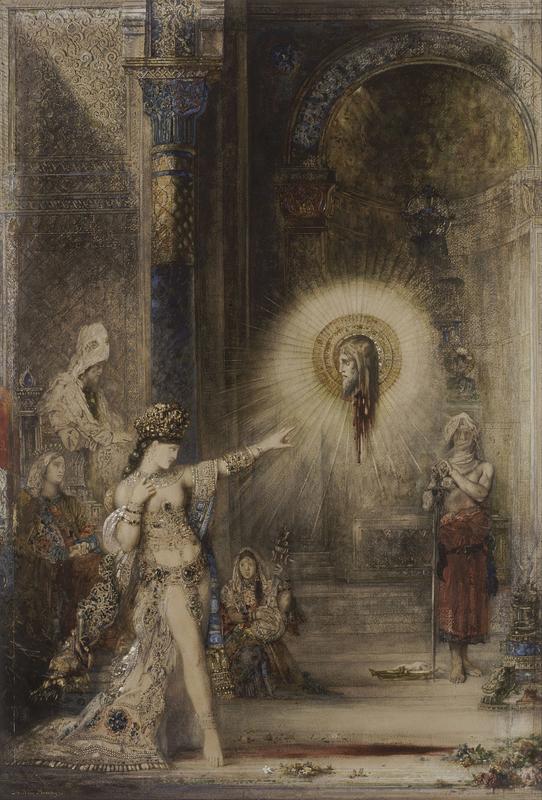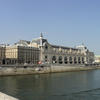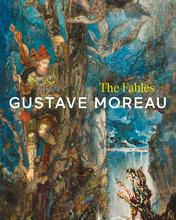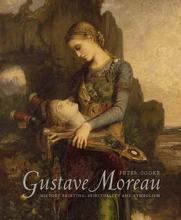More about The Apparition
- All
- Info
- Shop

Contributor
In the style of Gentileschi and Caravaggio, Gustave Moreau's The Apparition uses a grotesque and shocking image to tell a story and demonstrate a masterful use of light, composition, and color.
The narrative of the work, drawn from the Greek New Testament, Mark 6:16-29, is the typical story of the bloodthirsty tyrant, in this case a woman named Salome, who asks for the head of a martyr, instigated by her mother's taste for blood. The negative portrayal of women is not a topic of commentary for critics: on the contrary, they "Christianize" and elevate misogyny via the character of Salome, in the hopes of lending a transcendental spiritual gloss to their interpretations, which reflect an overall pessimism and histrionic sensibility. "Moreau's Salome paintings form a cornerstone for Huysmans' shift in aesthetic ideals. Huysmans...sees Moreau's Salome as the ultimate femme fatale:--'the soiled vessel, ultimate cause of every sin and every crime.' She is also the embodiment of artifice," and the cause for the thoroughly negative general attitude of the Decadent Movement toward the world: it is evil, because it is sensual and full of life.
It is wrong to ascribe to the artists themselves such ridiculous and nihilistic interpretations, but it is relevant to look at the critics of the time because their opinions, as tastemakers, had a general influence comparable today only to reality TV stars. Luckily, Huysmans' interpretation was by no means universal.
Marcel Proust's brilliant and cultured narrator, who often narrates for dozens of pages, specifically mentions The Apparition, sparing us the Huysmans-esque pseudo-theology. In typical Proustian style, the narrator of Le Côté de Guermantes II, part of the In Search of Lost Time saga, omits "Moreau's mythological symbolism and retrospective vision...leaving aside the deeper effects of Moreau's art that Proust leaves out of the narrative." It could be that Proust does this as a way to offer something for the reader to investigate, some hidden treasures in the library.
Sources
- Art History Students' Organization, Florida State University. Dept. of Art, Athanor, v. 7. Tallahassee: Florida State University, 1988.
- McDonald, Christie, and Francois Proulx. Proust and the Arts. Cambridge: Cambridge University Press, 2015.
- Modern Language Notes. Baltimore: Johns Hopkins University Press, 1947.
Featured Content
Here is what Wikipedia says about The Apparition (Moreau, Musée d'Orsay)
The Apparition (French: L'Apparition) is a watercolour by French artist Gustave Moreau, painted between 1874 and 1876. It shows the biblical character of Salome dancing in front of Herod Antipas with a vision of John the Baptist's severed head. The 106 cm high and 72,2 cm wide watercolor held by the Musée d'Orsay in Paris elaborates on an episode told in the Matthew 14:6–11 and Mark 6:21–29. On a feast held for Herod Antipas's birthday, the princess Salome dances in front of the king and his guests. This pleased him so much he promises her anything she wished for. Incited by her mother Herodias, who was reproved by the John the Baptist for her illegitimate marriage to Herod, Salome demands John's head on a charger. Regretful but compelled to keep his word in front of everyone present, Herod complies with Salome's demand. John the Baptist is beheaded, his head brought on a charger and given to Salome, who in turn gives it to her mother.
Moreau approached the biblical theme in 19 paintings, 6 watercolors and more than 150 drawings. Part of a series of at least 8 closely resembling paintings and more than 40 sketch drawings, it is regarded as a key work of Moreau's opus, symbolism and fin de siècle art in general. Upon its first presentation 1876 in Salon (French: Salon de Paris), the painting caused a sensation. It has since made a lasting impression on various artists, notably from the Decadent movement.
Check out the full Wikipedia article about The Apparition (Moreau, Musée d'Orsay)














